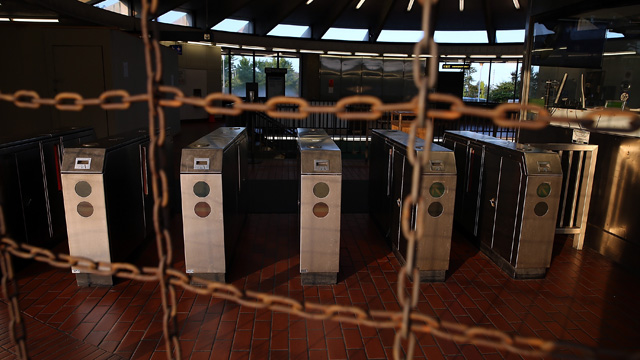The recent BART strike gave Bay Area commuters a taste of what happens when we lose a major segment of our transit system. So what would happen if more than one system shut down, or if there was a major earthquake? The transit advocacy group SPUR warns that our transportation systems are already at capacity and aren’t set to handle rapid population growth. SPUR executive director Gabriel Metcalf joins us to discuss how the Bay Area can become more resilient, and better prepared for the next disruption.
Show Highlights
Resiliency Equals Redundancy
“The key is to have redundancy in the system, and with San Francisco being a peninsula you can really think about this in terms of specific corridors. So, if the Golden Gate Bridge were to go down, tragically, how would that corridor work? In the Transbay/East Bay corridor, we can look at that same question. But it turns out there really is no way to replace what's now almost 400,000 people a day taking BART. The de facto decision most people made [during the strike], we think, is to stay home."
— Gabriel Metcalf
On Replacing or Backing Up BART Services
"There are 400,000 people that ride BART every day. And if you figure that the average ten car BART train probably carries more than 1,000 people, that would take a lot of buses in order to haul that many people. It's really impossible. You might be able to get all those buses and store an extra fleet of buses in Alameda. It would be expensive, but then you'd have to have drivers who are just standing by on call. It's literally impossible to have something that would replace the capacity.
— Michael Cabanatuan
On Enforcing Restricted Occupancy During Emergency Times
I'm not sure how politically realistic it is around [the Bay Area]. I'm sure there would be a lot of opposition to that. One thing they did do is along I-80 and at the Bay Bridge toll plaza, they extended the carpool hour lanes basically to all day. From, I think, 5 AM until 7 PM.
— Michael Cabanatuan
On Expanding Carpool Systems
I think that would probably help as well. You know, the east bay has the casual carpool system that coincidentally started in the 1970's during an AC Transit strike. That has proven to be very popular and worked very well going into the city. Coming out of the city and going back to the East Bay it's a little more problematic.
— Michael Cabanatuan
On Transit Authority's Coming Together
It's [about] coordination. It is making them work together. For example, there are transit agencies in Contra Costa that just run buses in Contra Costa. Perhaps they could run buses that go into the city. Perhaps AC Transit could run more buses that go across the Bay Bridge. Maybe people could shuttle passengers from, let's say, Walnut Creek to downtown Oakland where they would get on a bus. There's a whole variety of things that they could do, but it would require the agencies to work together and part of the reason that many of those agencies formed was to have local control and to serve their area, not the region.
— Michael Cabanatuan
- More: What the BART Strike Means for the Regional Transit Agenda – SPUR.org
- More: Rebuilding Our Transportation Infrastructure After a Disaster – Spur.org
